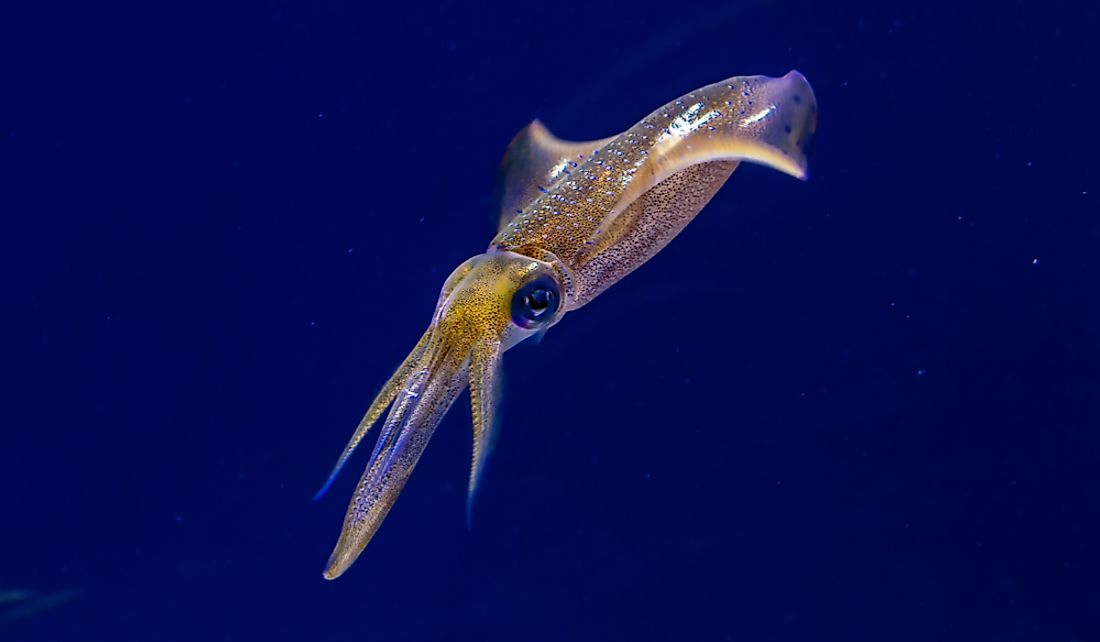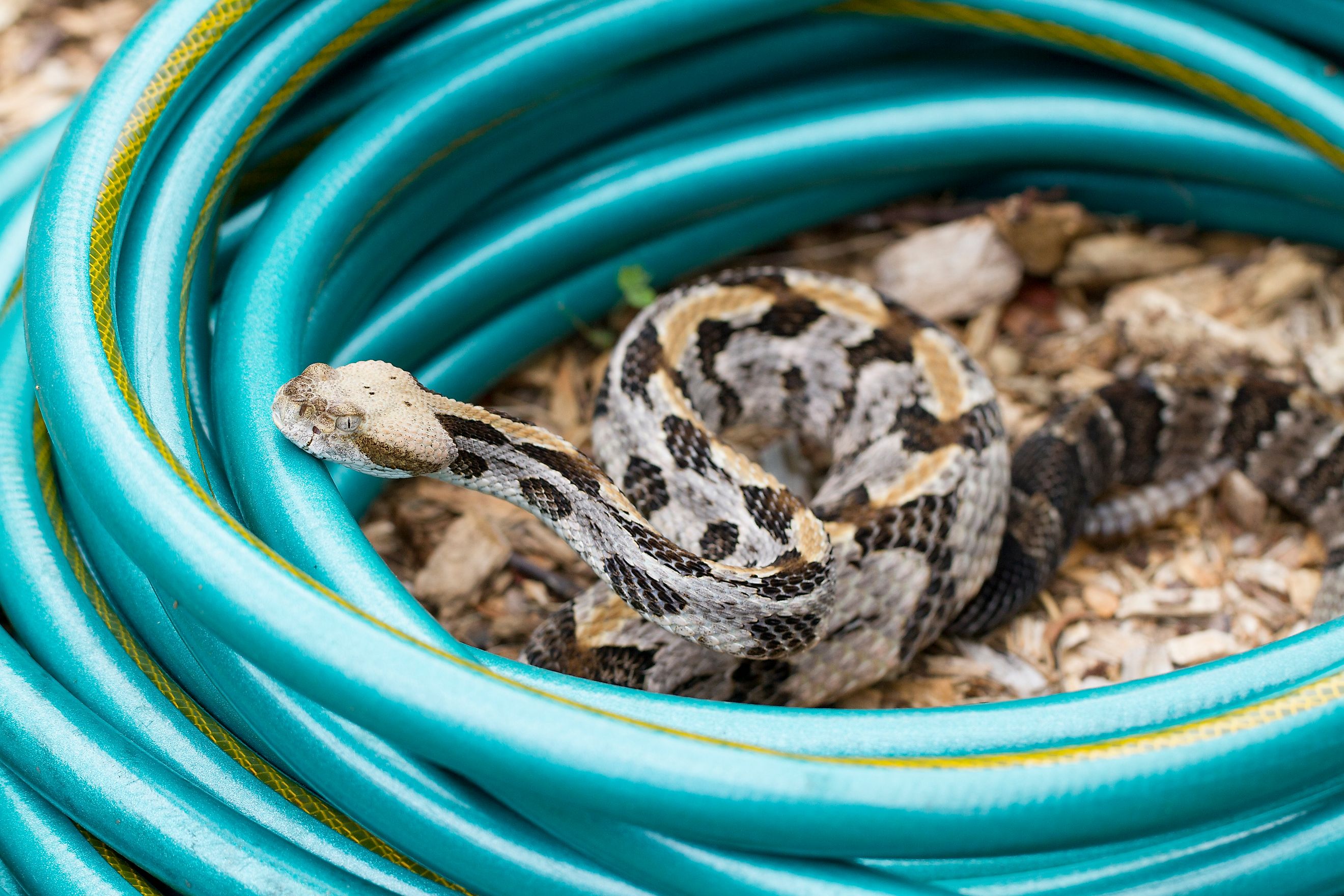
The Venomous Snakes Of Georgia
Being vital to Georgia's ecosystem, the state's venomous snakes are frequently misunderstood or feared. Learning about these native species is not just about safety; it’s about appreciating their ecological importance. Venomous snakes help to control rodent populations, which can protect crops and prevent the spread of disease. Furthermore, every species — from the copperhead to the eastern diamondback — provides us with a distinct perspective on the richness of Georgia's coastal plains, wetlands, and woods. By understanding these remarkable creatures and their habitats, we can support conservation efforts that protect Georgia’s natural heritage while ensuring safe coexistence for people and wildlife. Here are the venomous snakes of Georgia.
Carolina Pygmy Rattlesnake
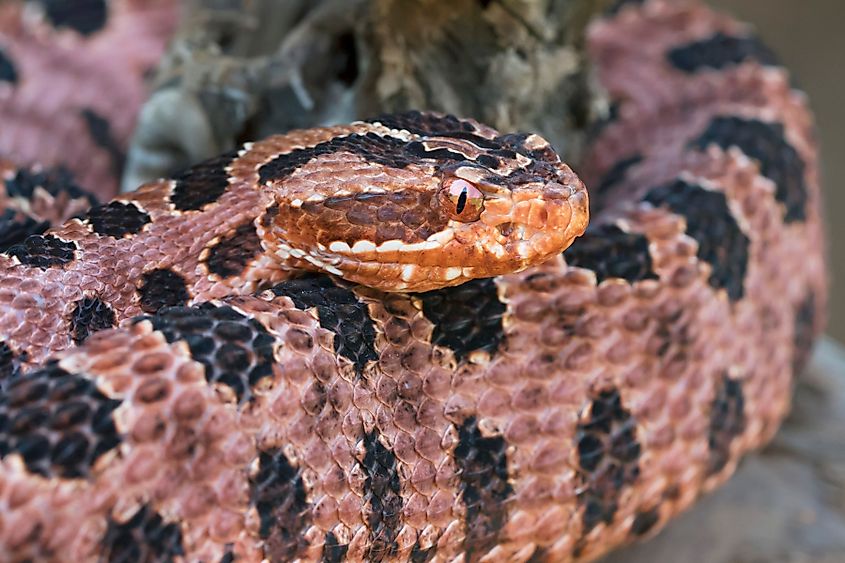
The Carolina pygmy rattlesnake (Sistrurus miliarius miliarius) may be small, but this stout little rattler certainly should be respected. Typically measuring just 1 foot to 2 feet in length, it sports a gray or reddish body with a rust-colored stripe along its spine, with dusky splotches. Dark markings run down its sides, and a distinctive dark cheek stripe from eye to jaw gives it a striking look, sometimes edged in white for extra flair. Among its unique features are nine enlarged head scales, vertical pupils, and heat-sensing pits that make it a skilled hunter.
This rattlesnake is at home in woodlands, swamps, and meadows. The species is known to gravitate toward secluded areas such as rocky outcrops, dense forests, and rural spots, where it aims to stay away from human activity. Its small rattling noise is so quiet you might not even notice it approaching; while usually on the shy side, the Carolina pygmy rattlesnake is venomous, so if you happen to cross paths, make sure to approach with caution.
Dusky Pygmy Rattlesnake
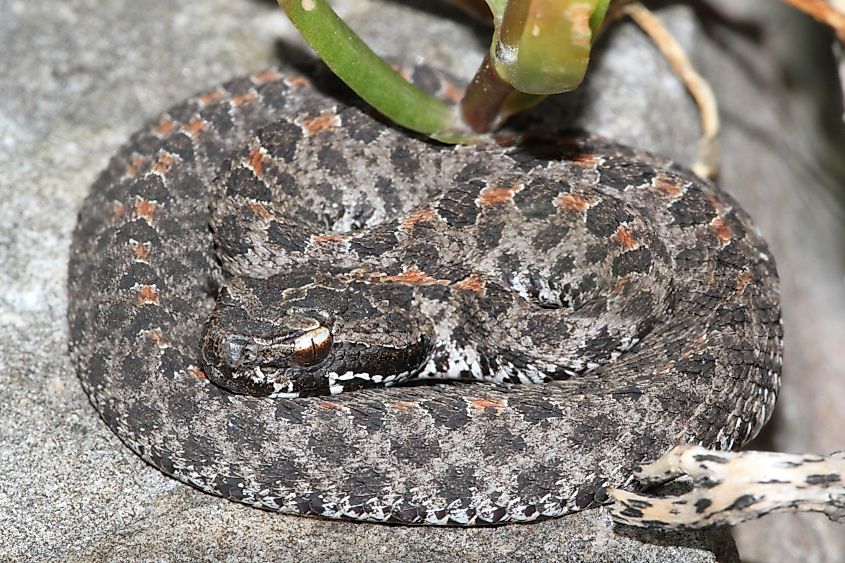
The dusky pygmy rattlesnake (Sistrurus miliarius barbouri) is a small, thick-bodied rattler that ranges in size from 1 foot to 2 feet, with record-setters at a modest 30 inches. Its brown or gray body possesses a reddish-orange stripe down the spine, topped with dark brown or black blotches. Dark cheek stripes run from its eyes to its jaw, sometimes outlined in white, with extra dark patterns decorating its sides. Its tail rattle is on the smaller side, making it more like a faint insect buzz. Nine enlarged head scales, cat-like pupils, and thermal pits give it a unique look, while its triangular head that stands out wider than its neck.
This rattlesnake loves dense forests, swamps, and grassy spots near water. It’s a master of camouflage, blending right into the leaf litter and underbrush of rural, wooded areas. Most active around dusk and at night, it uses those heat-sensing pits to track down small prey, such as rodents and frogs. Though it tends to avoid attention and is not prone to aggression, it’s still venomous, and bites can be very painful. If you find yourself in its territory, admire it from a distance.
Eastern Coral Snake
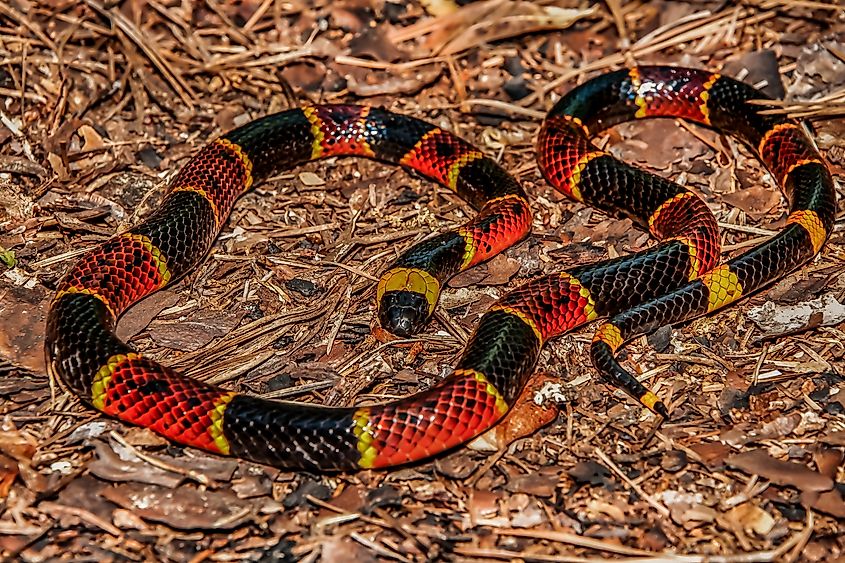
The eastern coral snake (Micrurus fulvius) is slender and brightly colored, and it usually measures between 2 feet and 3 feet in length, though some rare ones stretch up to around 50 inches. Its striking black, yellow, and red rings make it easy to spot, with its thin yellow rings touching red and black bands. This pattern distinguishes it from the harmless kingsnake, which has the same colors, but does not have red bands touching yellow. (A simple rhyme can help separate the two: "Red touch black, friend of Jack; red touch yellow, kill a fellow." Plus, its black nose is a helpful hint to set it apart from similar snakes.) Eastern coral snakes are highly venomous and, unlike pit vipers, their fangs are fixed rather than hinged.
You’ll find these snakes tucked away in wooded, sandy areas, swamps, and scrublands. Because of their innate ability to blend in, they frequently sneak undetected beneath leaves, logs, or soil, avoiding people wherever possible. When threatened, the eastern coral snake tucks its head under its body and raises its tail in order to confuse predators by showcasing its "second head." These snakes like to keep to themselves, rarely biting unless accidentally stepped on or picked up. It is advised to observe from a safe distance if you spot one.
Eastern Cottonmouth

The eastern cottonmouth (Agkistrodon piscivorus) is a hefty, fearsome-looking snake often known as the water moccasin. Typically 2 feet to 4 feet in length, some can reach 6 feet or more. This snake’s color palette ranges from dark olive and brown to nearly jet black, often with shadowy patterns along its back and sides. It also has a defining dark stripe from each eye down the side of its head, framed by a lighter pinstripe on top and a contrasting light shade below. With vertically elliptical pupils and infrared radiation sensors between the nostrils and eyes, the eastern cottonmouth has all the well-known features of a pit viper. Baby snakes, meanwhile, show off brighter patterns and a yellow-tipped tail they wiggle to lure in prey, such as frogs and lizards.
This snake is most at ease in freshwater habitats, including lakes, rivers, ponds, and swamps. One of only three venomous water snakes in North America, it’s a creature of rural and wetland areas rather than suburban spaces, and it has a reputation for standing its ground rather than slinking away. When challenged, it gets into its protective stance, coiling and opening its mouth to show off the cotton-white inside. The eastern cottonmouth isn’t particularly aggressive; it bites only when it feels cornered or threatened. Although many nonvenomous water snakes share similar habitats, the eastern cottonmouth stands out with the way it keeps its head high above the water as it swims.
Eastern Diamondback Rattlesnake
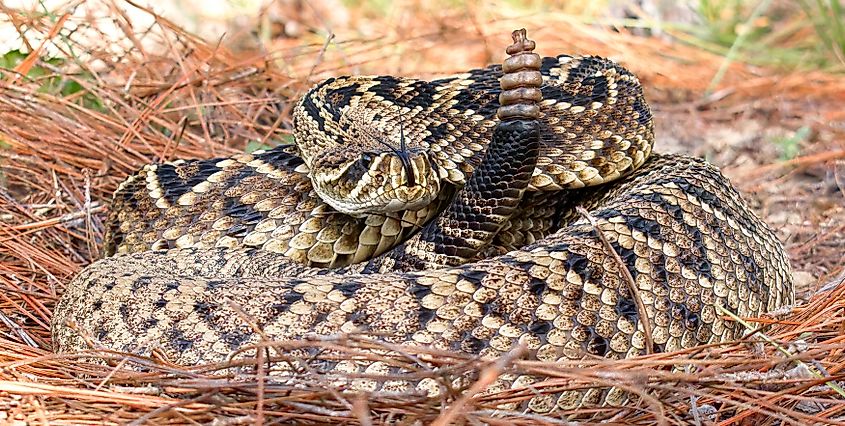
The eastern diamondback rattlesnake (Crotalus adamanteus), is a real heavyweight in the snake world, holding the crown as the largest rattlesnake species — and one of the heaviest venomous snakes — in the Americas. Adults stretch between 3 and 6 feet long, but some have hit a jaw-dropping 7 feet or 8 feet. Its body is covered with dark diamond patterns along its spine, each filled with brown and outlined in beige, fading to banding or disappearing as they near the tail. Dark streaks run along each side of its broad, triangular head, bordered by stripes, while its elliptical pupils and heat-sensitive receptors mark it as a classic pit viper.
You’ll find the eastern diamondback prowling across sandy woodlands, pine flatwoods, coastal dunes, and scrublands. Its impressive camouflage helps it blend into these environments, staying relatively hidden from the eye. It prefers the peace of rural and undeveloped areas over bustling suburban or urban spaces. This is a mostly solitary snake that’s active by day — though, in the peak of summer, it might switch up its schedule to cooler nights.
When threatened, the eastern diamondback doesn’t hide its power; it tightens and raises that rattle to deliver a clear, unmistakable warning. They're not aggressive by nature, but they're more than capable of defending themselves if pushed, packing a painful and dangerous bite that it saves as a last resort or for taking down prey like small mammals, birds, and reptiles.
Florida Cottonmouth
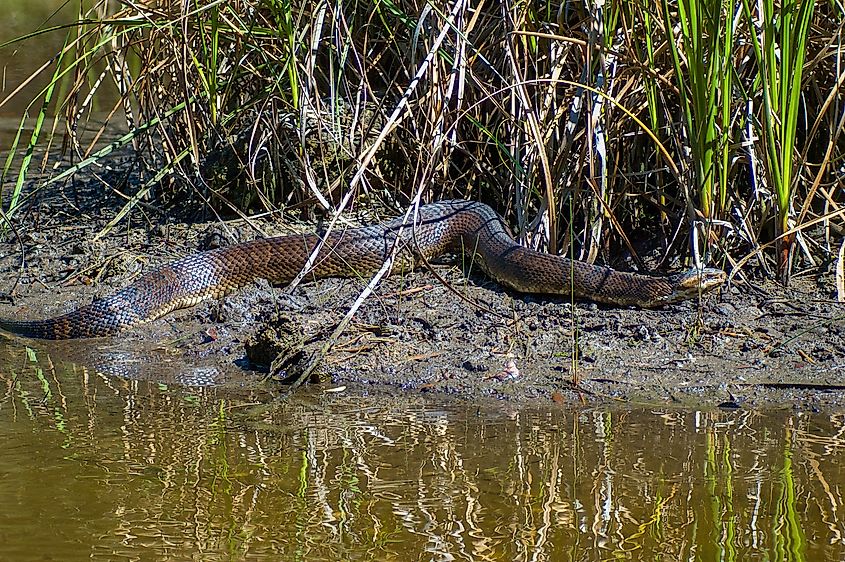
The Florida cottonmouth (Agkistrodon conanti), also known as the water moccasin, is a thick-bodied, venomous snake that can grow up to 6 feet in length; however it normally only reaches 3 feet or 4 feet. With a dark olive, brown, or nearly black body, it often has faint serrated bands and a distinctive dark stripe on each side of its head, bordered by a pinstripe. Its belly is a yellowish white to tan shade, dotted with dark blotches, and its triangular head is topped with slit-shaped pupils. Like other cottonmouths, the young come with a brighter pattern and a yellow or green-tipped tail, which they wiggle to entice prey.
This snake loves to be around freshwater spots like lakes, ponds, rivers, and swamps. Cottonmouths usually stay in the countryside, though they occasionally wander into suburban spaces near water. Known for its theatrical defensive display, the Florida cottonmouth coils up, opens its mouth wide to reveal its cotton-white interior, and might even release a musky odor to ward off threats. While these snakes have a scary reputation, they’re reported to be passive, only striking if provoked, and usually only pose a risk if stepped on or otherwise disturbed. However, its venom is powerful and can be lethal.
Copperhead
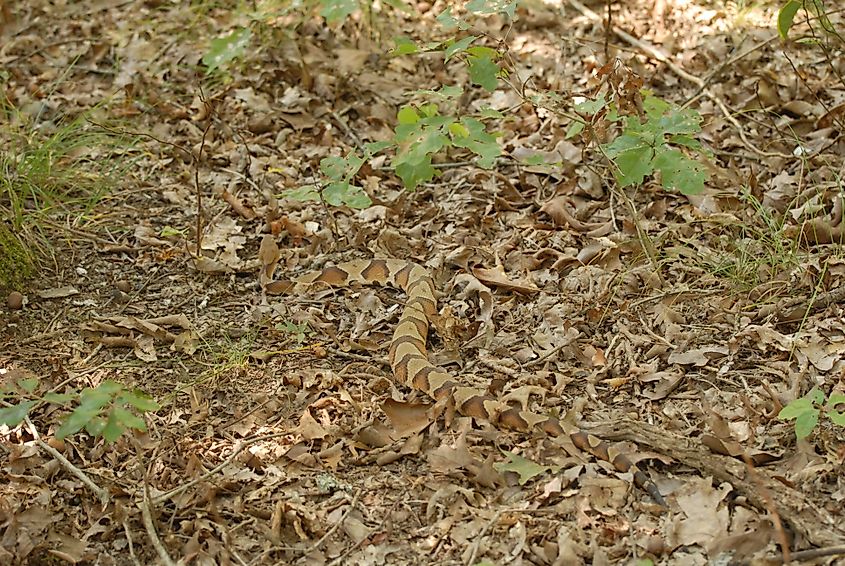
The copperhead (Agkistrodon contortrix), aptly named for its copper-red head, can grow to 2 feet or 3 feet in length, though a few giants reach up to 4 feet. Draped in tan to light tan or pinkish tan to reddish brown, it’s decorated with dark brown to reddish-brown hourglass bands that pinch in along its spine and widen out along its sides. In many copperheads, these bands don’t quite meet in the middle, giving each side a row of dark triangles instead. Young copperheads have the same stylish pattern but are grayer; with a flashy, yellow-tipped tail they wiggle like bait to attract frogs and lizards. And, like a pit viper, it has those iconic elliptical, cat-like pupils and pit organs for tracking down dinner.
This adaptable serpent is right at home basking in forests, hiding among rocky outcrops, and even in suburban areas where nature provides some cover. When it feels threatened, the copperhead may freeze, relying on its camouflage to protect it. However, it can put on quite a defensive display, winding up and raising its head at a 45-degree angle while vibrating its tail. They're more likely to strike as a last resort, usually reserving bites for situations when they're threatened.
Timber Rattlesnake
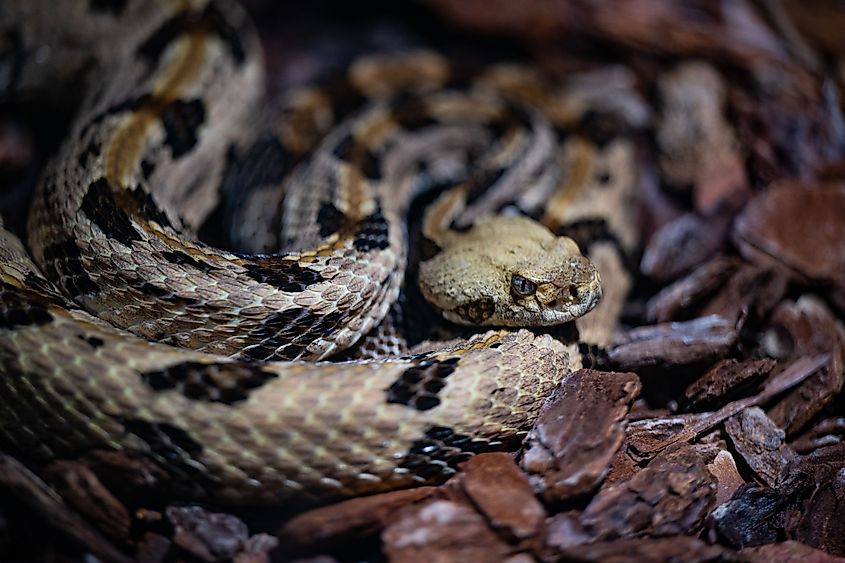
The timber rattlesnake (Crotalus horridus) is a heavyweight among rattlers, typically spanning 3 feet to 5 feet, but some are up to a full 6 feet. This snake is a true chameleon of the eastern US, showing off colors that vary by region. In the north, it’s usually decked out in yellowish-brown or gray with dark, blotchy patches that morph into bands along its body. Down south, this rattler’s commonly known as the canebrake with a pinkish-gray or brown tone, complete with a reddish-brown racing stripe down its spine, topped with bold, black chevron-shaped bands and a pitch-black tail.
Timber rattlesnakes are homebodies of serene forests, rocky spots, and grasslands, but they’re known to show up in open fields or even near suburban edges when they’re on the move. They’re patient hunters, armed with thermal receptors that make them effective predators from spring through fall. If threatened, the timber rattlesnake takes a defensive stance, rattling away with nature’s own warning alarm. Though mild-mannered, this is one snake you don’t want to rile up; its venom is highly toxic.
Conclusion
Despite their potential for harm and to invoke fear, the venomous snakes of Georgia are crucial to the preservation of ecological balance because they regulate prey populations and promote diversification. Georgia locals and visitors of all ages need to be more aware regarding these animals' identities, behavior, and habitats to minimize accidental encounters and to make outdoor areas safer and more fun. By recognizing the significance of these snakes and respecting their habitat, we can help conservation efforts to protect the species and Georgia's rich natural beauty. So the next time you step outdoors, keep in mind that coexisting with these intriguing reptiles scattered across the Peach State requires knowledge, awareness, and respect.





